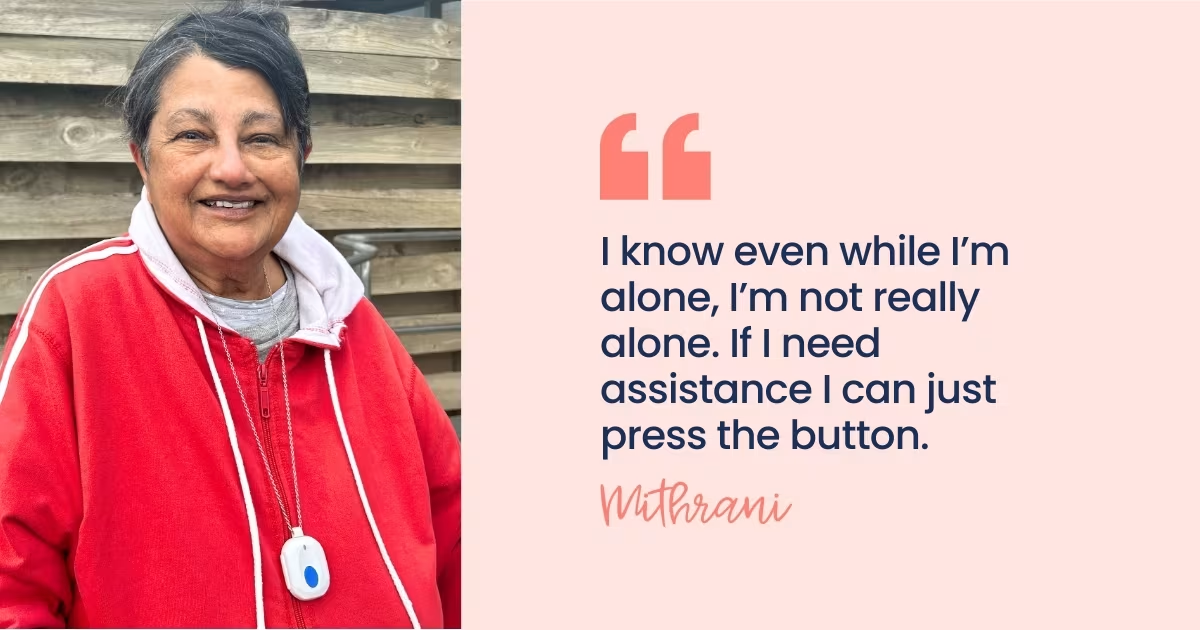Real Stories
Finding peace of mind with MePACS
We receive so many letters, emails and cards of thanks and every one of those is cherished as we take so much pride in what we do. To know that we are genuinely making a difference in so many lives is utterly rewarding.
Don't just take our word for it. Here is just a sample of some of the testimonials our clients have provided over the years.

Client stories
What our Clients Say

Before the MePACS Education Session, my team was unaware of the vast array of falls detection and alert devices that MePACS now offers.
Since the MePACS Education Session, the team has expressed excitement about the available devices and has been discussing their suitability for particular clients. MePACS was happy to answer the team's questions and discuss how MePACS can support our clients in remaining safe in their homes for longer.


The MePACS staff are lovely, they answer quickly, and I have confidence in the service – I feel that I can rely on them to get me emergency help should I need it.


They have my medical details on file, so I know they can tell emergency services on my behalf – that’s very reassuring.


MePACS saved my life actually. I wouldn’t be here if it wasn’t for MePACS because nobody would have come to check on me. It’s an excellent service.


I was looking for professional, caring and reliable support and I chose MePACS because the service met my exceptionally high standard requirements.


I am so impressed with the MePACS service. I always have my Home Alarm around my neck, and I wear it in the shower too. When I go out, then I switch it for the MePACS Mobile Alarm and I can even take that on holiday with me.


I have the confidence to go anywhere with MePACS watching out for me. It does make me feel very safe, especially when I am out. Since receiving the Solo, I’ve been for more walks around my neighbourhood, and I know I’m covered if I have a fall.


I wanted a personal alarm that I could take out shopping with me, or to see my friends, and I would have it just in case anything happened. It’s another way for me to feel more secure while I do the things that I enjoy.


It’s a life changer, knowing that someone is there for me. It’s easy to use. You just press the red icon on the screen, you hear a few beeps, and then an operator from MePACS talks to you through the watch.


MePACS has restored my confidence to go out by myself. If you’re a senior who lives alone like me, I would certainly recommend a MePACS alarm. It is essential for us.


MePACS is excellent. The most important thing to me is that I feel secure with it – I’m not a nuisance to anyone around the place, I just push a little button and MePACS will answer in what feels like no time.


“MePACS has got, without a doubt, the politest and nicest people. They never seem to be busy, even though you know they are, they’re terrific. I’d give up all my other possessions before I gave up my MePACS alarm.


I feel safe and supported to keep living independently with MePACS. They give me peace of mind because I know I can rely on them to answer when I press the pendant for help. The response team are there 24/7, and they have my medical details on file so they’re aware of what emergency assistance I may require.


I was always worried about walking too far, but now the MePACS Mobile Alarm makes me feel more secure. If anything happens, I know help is available 24/7.


I completely trust MePACS and they have never let me down. Knowing that I have help at hand 24/7, in any location with my MePACS Mobile Alarm just restores my confidence completely. I can wander around the countryside if I wanted to.



.jpg)
.jpg)
.jpg)


